In This Chapter
Taking BlackBerry Curve Anatomy 101
Understanding general navigating guidelines
Using common shortcut keys
Regardless of whether you previously owned a BlackBerry, you might have heard that the new BlackBerry Curve is totally different. You might be wondering how you spot a new BlackBerry Curve. Looks aren’t deceiving in this case. From the outside, the new BlackBerry Curve 8500 is updated with an optical trackpad instead of a trackball — no more problems with the trackball getting stuck. The BlackBerry Curve 8500 design also has three media keys on the top. The BlackBerry Curve 8900 is slim and has a simple and elegant physical design. Bear with us, and you will be master of your BlackBerry Curve in no time.
Anatomy 101: The Body and Features of Your BlackBerry Curve
In this section and the following sections, we show you all the keys and features on your BlackBerry Curve. Figure 2-1 shows the primary ones for the Curve 8500 (see Figure 2-2 for the additional keys on the 8900), which are as follows:
Convenience keys: With BlackBerry Curve, you have two convenience keys. By default, the convenience keys are preprogrammed to open an application.
In Chapter 3, we show you how to reprogram the convenience keys so that they display the programs you use the most.
Display screen: This screen is the graphical user interface (GUI) on your BlackBerry Curve.
End key/Power key: While on a phone call, use this key to end your call. If not on a phone call, press this key to jump straight back to the Home screen from wherever you are. Press and hold this key to turn your BlackBerry Curve on or off.
Escape key: This is the key to the right of the trackball or trackpad. Use this key to cancel a selection or return to a previous page within an application. If you hold this key down, it returns you to the Home screen from any program.
Media keys (BlackBerry Curve 8500): There are three media keys: Play/ Pause key, Next Track key, Previous Track key. Play/Pause is used also to open Media Player (Chapter 14).
Menu key: Use this key to display the full menu of the application you’re using.
microSD slot: The BlackBerry Curve has a microSD slot beneath the battery cover.
Mute key: This key mutes a call when on a call.
Screen Lock key: This key lets you quickly lock your screen before you slide your phone into your pocket.
Send key: Because your BlackBerry Curve can also function as a cellular phone, this key allows you to go straight to the Phone application, regardless of which application you are currently using. When you are already in the Phone application, the send key starts dialing the number you entered.
Trackball or trackpad: The Curve 8900 has a trackball; the 8500 has a trackpad. Navigate the display screen in four directions with the trackball or trackpad. When you press the trackball or trackpad, the short menu of the application you’re using appears.
QWERTY keyboard: The keyboard is the input for your BlackBerry Curve — very straightforward.
Two types of contextual menus can appear on your BlackBerry Curve:
Full menu: Lists all the options and features you can perform (see Figure 2-3, left). The full menu is accessed by pressing the menu key.
Short menu: An abbreviated list of the full menu (see Figure 2-3, right). The short menu is accessed by pressing the trackball when you aren’t prompted by a dialog box.
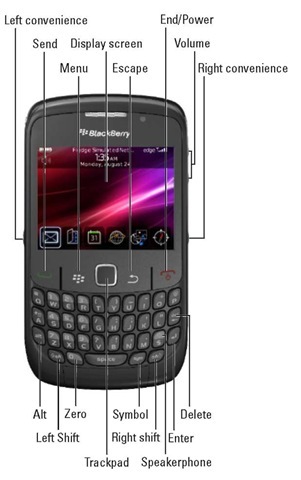
Figure 2-1:
BlackBerry Curve 8500.
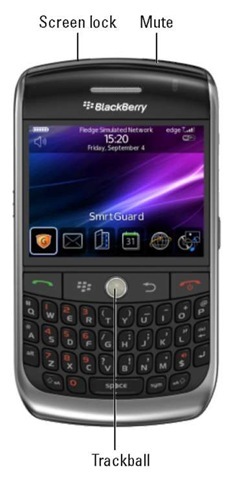
Figure 2-2:
BlackBerry Curve 8900.
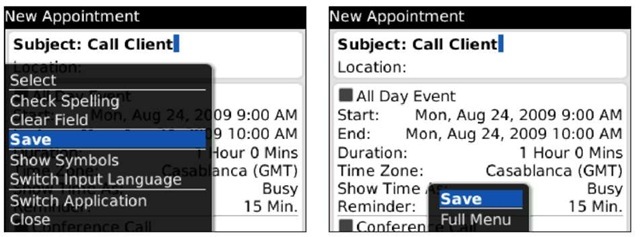
Figure 2-3:
Examples of a full menu and short menu in the Memo application.
Display screen
When you first turn on your BlackBerry Curve, the display screen displays the Home screen, which is your introduction to the interface of your BlackBerry Curve. The different icons represent the different applications in your BlackBerry Curve. See Figure 2-4 for an example of what your Home screen might look like.
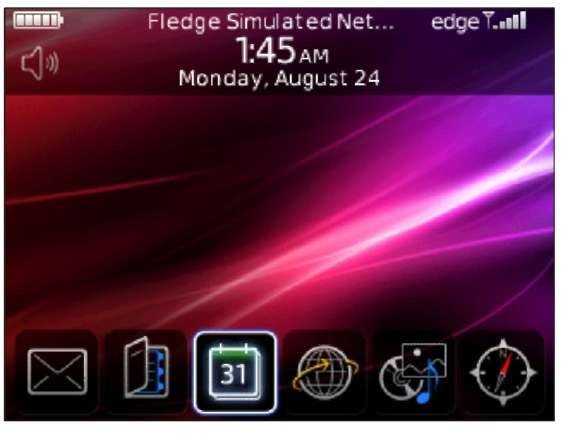
Figure 2-4:
Your BlackBerry Curve might come with a Home screen like this.
Depending on the theme you’re using, your applications might be listed in text form rather than as icons. Remember that how your GUI looks depends on how you want it to look because the font and theme are customizable. For more on personalizing your BlackBerry Curve, see Chapter 3.
QWERTY keyboard
Unlike some PDA manufacturers — and they know who they are — RIM (Research In Motion) chose the same QWERTY keyboard you know and love from your personal computer as the BlackBerry Curve input method. That was a great decision because it means you don’t have to master some new way of writing — graffiti or whatever — to get data into your Curve. All you have to do is type on a familiar keyboard — and you already know how to do that.
How you type on your BlackBerry Curve is up to you, but most people find that typing with two thumbs is the most efficient method.
Escape key
Simple yet useful, the escape key allows you to return to a previous screen or cancel a selection. The escape key is the arrow key to the right of the trackball.
Trackball and trackpad
You can perform two functions with the trackball or trackpad: navigating and pressing. When you navigate with your trackball or trackpad, you can move the cursor about the display screen in four directions. In a text-filled screen, such as the body of an e-mail, you can usually navigate through the text in four directions.
Depending on where you are on the BlackBerry Curve’s screen, different situations determine what happens when you press the trackball or trackpad, also called the trackball or trackpad click:
Display a drop-down list: When you’re in a choice field, pressing the trackball or trackpad displays a drop-down list of choices for that field.
Confirm a choice: The trackball or trackpad can also function as a confirmation key. For example, when you need to select a choice in a drop-down list, you can press the trackball or trackpad to confirm the highlighted choice.
Display a short menu: When you’re in a text-filled screen (an e-mail body or a Web page), pressing the trackball or trackpad displays a short menu (refer to Figure 2-3, right), which is just an abbreviated version of the full menu. You get the full menu by pressing the menu key.
Menu key
The menu key brings up the full menu for the application you’re using. When on the Home screen, pressing the menu key displays a list of applications installed on your BlackBerry Curve. If you want to change the order of the applications in the list, see Chapter 3.
When you are on the Home screen, the behavior of the menu key depends on the BlackBerry Curve theme. The behavior just described is based on the default theme. See Chapter 3 for more on changing themes.
The microSD slot
Your BlackBerry Curve comes with 1GB of internal memory. If you’re a music or video fan, you know that 1GB can’t keep you entertained for a long commute. But no need to worry. The folks at RIM incorporated a microSD slot into your BlackBerry Curve so that you can add extended memory and store all the media files you want. The BlackBerry Curve supports up to a whopping 32GB microSD card.
You can purchase a microSD card separately for a relatively low price these days. At the time of this writing, a 16GB microSD card costs about $20, and a 32GB microSD costs about $40.
General Navigation Guidelines
In this section, we go over general shortcuts and navigation guidelines. On a Web page or an e-mail full of text, you can perform the tasks listed in Table 2-1.
| Table 2-1 Curve Keyboard Shortcuts | |
| Action | To Do This |
| Press the T key | Move to the top of the |
| page | |
| Press the B key | Move to the bottom of |
| the page | |
| Press the Space key | Move to the top of the |
| next page | |
| Press and hold the Shift key, and scroll the trackball | Select a line |
| horizontally | |
| Press and hold the Shift key, and scroll the trackball | Select multiple lines |
| vertically | |
| Press and hold the Shift key, and press the trackball | Copy selected text |
| Press and hold the Shift key, and press the Delete key | Cut selected text |
| Press and hold the Shift key, and press the trackball | Paste text |
| Press a letter key, and scroll the trackball | Insert an accented |
| character | |
| Press the Sym key, and press the letter below | Insert a symbol |
| the symbol | |
| Press Alt+Right Shift | Turn on caps lock |
| Press Alt+Left Shift | Turn on num lock |
Switching applications
When you’re navigating in an application, an option called Switch Application appears when you press the menu key. Switch Application (similar to Alt+Tab in Windows) lets you multitask between applications (see Figure 2-5).
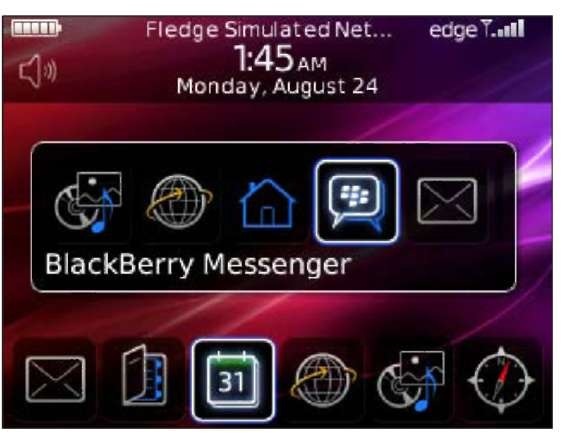
Figure 2-5:
Switch Application menu.
The quickest way to get to Switch Application is to press and hold the menu key for 2 seconds.
Changing options
Throughout this topic, you see examples of an options field being changed to a different value. The easiest way to change the value in a field is to first use the trackball or trackpad to highlight the field. Then press the trackball or trackpad to display a drop-down list of choices, such as the ones shown in Figure 2-6, and finally press the trackball or trackpad again to make your selection.
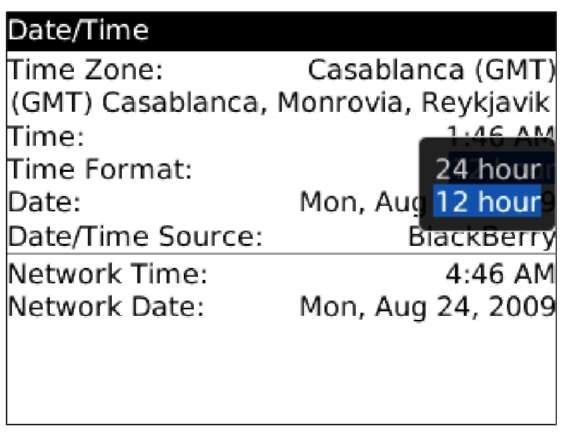
Figure 2-6:
An example of an option field’s drop-down list.
General Keyboard Shortcuts
In many instances in this topic, when you’re asked to go to a BlackBerry Curve application (Profile, for example), you have to first highlight the application icon from the Home screen and then click the trackball or trackpad. You may be thinking, “Hey, there must be a shortcut for this,” and you’re right. This section and the ones that follow cover such general keyboard shortcuts, all in the name of making your life easier. (Shortcuts that are more application-specific are covered in the chapter dealing with the particular application.)
Before you get all excited about shortcuts, you need to take care of one bit of housekeeping. To use some of these general keyboard shortcuts, you first have to make sure that the Dial from Home Screen setting — buried deep within the Phone application — is turned off.
Inquiring minds want to know, so we’ll tell you. The Dial from Home Screen option is designed for users who make frequent BlackBerry Curve phone calls. If you aren’t a frequent phone user and want to access all applications with a press of a button, get ready to ditch Dial from Home Screen.
Here’s how to turn off the Dial from Home Screen setting:
1. From the BlackBerry Curve Home screen, highlight the Phone application and then press the trackball or trackpad.
2. Press the menu key and then select the Options menu.
A screen that lists a range of options appears.
3. Select General Options.
The General Options screen appears.
4. Highlight the Dial from Home Screen field and then select No.
Doing so shuts down the Dial from Home Screen option, enabling you to use Home-screen shortcuts.
5. To confirm your changes, press the menu key and then select Save from the menu that appears.
If you’re a frequent phone user on your BlackBerry Curve, as opposed to an e-mail or Internet user, you may not want to turn off the Dial from Home Screen feature.
Using Home screen shortcuts
When you disable the Dial from Home Screen feature, you are free to use any Home screen shortcut. (The name for these shortcuts is actually a pretty good fit because you can use these shortcuts only while you are on the Home screen.)
Okay, here goes. To call up the application listed in the first column of Table 2-2, press the key listed in the table’s second column.
| Table 2-2 | Home Screen Shortcuts |
| Application | Shortcut Key |
| Messages | M |
| Saved Messages | V |
| Compose | C |
| Search | S |
| Contacts | A |
| Tasks | T |
| Profile | F |
| Browser | B |
| Calendar | L |
| Calculator | U |
| MemoPad | D |
| Keyboard Lock | K |
| Phone | P |
Other (non-Home screen) shortcuts
The following shortcuts can be used at any time, regardless of which screen you’re in — or whether you have Dial from Home Screen enabled, for that matter:
Soft Device Reset (also known as the three-button salute): Pressing Alt+Shift+Del forces a manual soft reset, which is just what you need when your BlackBerry Curve crashes or when you install an application and it needs a manual reset. You can do a hard reset by pulling out the battery from the back of the BlackBerry Curve. Without getting into the technical jargon, from a BlackBerry Curve user’s perspective, a hard reset takes longer and is usually the last resort to solve any issues before contacting the help desk.
HelpME: In the BlackBerry world, SOS is actually spelled Alt+Shift+H. Use it when you’re on the phone with technical support. (It gives support personnel info such as your BlackBerry PIN, memory space, and version number so that they have information about your BlackBerry Curve when they try to troubleshoot your problems.)
The BlackBerry PIN isn’t a security password; rather, it is a unique number that identifies your BlackBerry Curve, sort of like a serial number. But unlike a serial number, a BlackBerry can message another BlackBerry by using PIN-to-PIN messages (please see Chapter 9).
